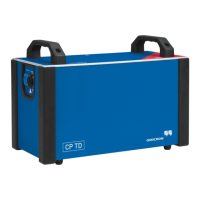OMICRON 59
High-voltage bushings
6.2.7 Oil-impregnated paper-insulated
A bushing where the internal structure is made of cellulose material impregnated with oil.
6.2.8 Resin-bonded paper-insulated
A bushing where cellulose material bonded with resin provides the major insulation.
6.2.9 Solid, ceramic
A bushing where a ceramic or other similar material provides the major insulation.
6.2.10 Gas insulated
A bushing that contains compressed gas like SF6 or mixtures of SF6 with other gasses i.e. N2. This type
is frequently used for circuit breaker bushings.
6.3 Capacitance and DF measurement on high-voltage
bushings
The dissipation factor test is the most effective known field test procedure for the early detection of
bushing contamination and deterioration. It also measures alternating (AC) test current, which is directly
proportional to bushing capacitance.
Bushing dissipation factor and capacitance should be measured when a bushing is first installed and
also one year after installation. After these initial measurements, bushing power or dissipation factor and
capacitance should be measured at regular intervals (3 to 5 years typically). The measured values
should be compared with previous tests and nameplate values.
Note: Large variations in temperature significantly affect dissipation factor readings on certain types of
bushings. For comparative purposes, readings should be taken at the same temperature. Corrections
should be applied before comparing readings taken at different temperatures.
Bushings may be tested by one or more of four different methods, depending upon the type of bushing
and the dissipation factor test set available. For more detailed instructions on this test procedure, see
the dissipation factor test set instruction book from the appropriate manufacturer. The four test methods
are described as follows:
6.4 Ungrounded Specimen Test (UST)
This test measures the insulation between the center conductor and the capacitance tap, the dissipation
factor tap, and/or ungrounded flange of a bushing. This test may be applied to any bushing in or out of
the apparatus that is either equipped with capacitance or dissipation factor taps, or with the flange that
can be isolated from the grounded tank in which the bushing is installed. The insulation resistance
between the taps or insulated flanges and ground should be 0.5 M or greater. While in this case anything
that is attached to the bushing would also be energized, only the insulation of the bushing between the
center conductor and the ungrounded tap or flange would be measured. In the case of bushings
equipped with capacitance taps, a supplementary test should always be made on the insulation between
the tap and the flange.

